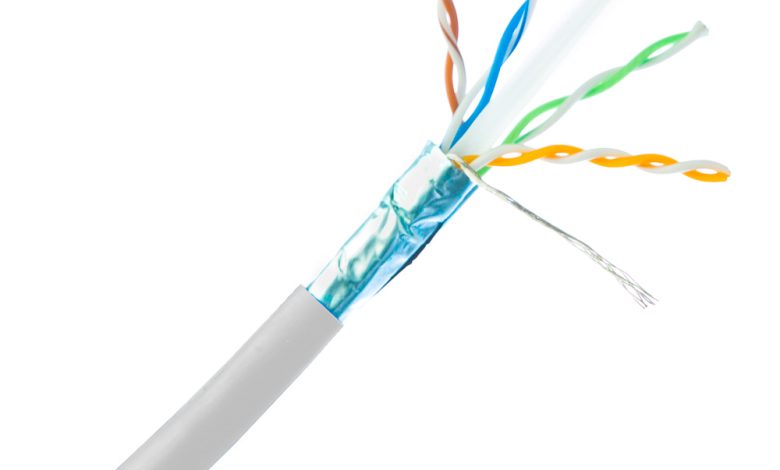Is the Cat6 Shielded Plenum Cable Really Safe?

Having a safe bulk ethernet cable in your LAN network is a necessity as well as a reason to be at peace with your safety insecurities. If you have some outdated ethernet cables installed in your network, you probably are a little anxious.
That is even more true if you are using those outdated cables for PoE applications – which needless to mention, use far more electric power than other ethernet applications such as audio and video transmissions.
Shielded Ethernet cables are well known for their safety features. And the Cat6 Shielded Plenum Cable is arguably the safest of all ethernet cables. It has a plenum jacket that is made out of the highest grade materials. But does using the highest grade materials in the jacket of the cable make it the safest? Well not necessarily, and so it demands an inquiry.
What is Cat6 Shielded Plenum Cable?
The Cat6 shielded Cable is the 6th category ethernet cable with 4 twisted pairs of 23 AWG wires. The cable is standardized according to the EIA/TIA 568 A and B wiring scheme. Bulk Cat6 cables were introduced to cater to LAN networks with a high-performance requirement. The Cat5 and its enhanced variants could not support gigabit speeds at 100 meters which was the main reason for the introduction of the improved Cat6 cables 1000ft.
Specifications: The Cat6 shielded plenum cable has a data transfer rate of 1 GBit/s over 100 meters and 10 GBit/s over 50 meters. It also supports a whopping 550 MHz bandwidth and can be used for all high-speed ethernet applications.
What makes an Ethernet Cable Safe?
You need to understand what a safe ethernet cable means to actually understand the factors that make an ethernet cable safe.
Safety in an ethernet cable primarily means that it can withstand high temperatures without causing a fire hazard.
Now, there are certain factors that make a cable safe. The most important factor is the cable jacket. Then it is the cable conductor that plays a pivotal role in the safety of the cable.
Cable Jacket
For instance, the plenum-rated conductor of the Cat6 shielded cable is made out of low smoke zero halogen materials that are highly resistant to extreme temperatures. What it does is that if the cable conductors overheat, the jacket will resist while ensuring that it does not catch fire.
If it does catch a fire (very unlikely), it will not allow its propagation along the cable. This ensures that the cable does not transport fire to other parts of the building. Lastly, the cable jacket emits extremely tiny amounts of smoke which is non-toxic and does not pose a threat.
Cable Conductor
Another factor that makes a cable safe, or unsafe thereof, is the cable conductor. There are copper-clad aluminum conductors which are unreliable for applications that consume more electric power than average ethernet applications. This causes them to overheat and the potential for fire hazards.
So, if the cable conductors of the shielded Cat6 plenum are made out of pure copper, the cable is most likely to be a safer solution with a reduced risk of overheating.
Does the shielding in Cat6 make it safer?
The term ‘shielding’ might sound assuring to some people who might wonder if it makes the Cat6 plenum cable any safer? The answer is actually, yes. But the shielding makes it safer in an indirect way.
Here’s how.
The purpose of integrating shielding in the cable is to prevent EMI and crosstalk from interfering in the signal transmission. It basically absorbs the noise from other cables in the network. This makes the job of the conductor much easier which ultimately prevents it from overheating. And the threat of the cable catching fire due to overheating is minimized, if not entirely dismissed.
Cat6 plenum safety: Key features
So, coming to the main subject, what safety features does the Cat6 shielded plenum has to offer, and does those features really make it safe?
1. Plenum Jacket: The highlight of the cable is its plenum jacket which is better than any other jacket out there. It does not catch fire, is durable, and resistant to extreme temperature, humidity, etc.
2. Bare copper conductor: Note that this cable comes in two different types of conductors. The first one is a CCA and the other one is a bare copper conductor. If you get the Cat6 cable with the bare copper conductor, you can rest assured that it will not overheat nor will it spark a flame.
3. Shielding: The cable is shielded as well which adds an extra layer of safety to the cable.
Is it safe?
Cat6 shielded plenum cable is as safe as ethernet cables can be. Its plenum-rated jacket, bare copper conductor, and the shielding around it are the ultimate safety features that make the cat6 cable the safest of all.
Conclusion
We hope this blog helped clear your ambiguities related to the safety features of the Cat6 plenum cable.





